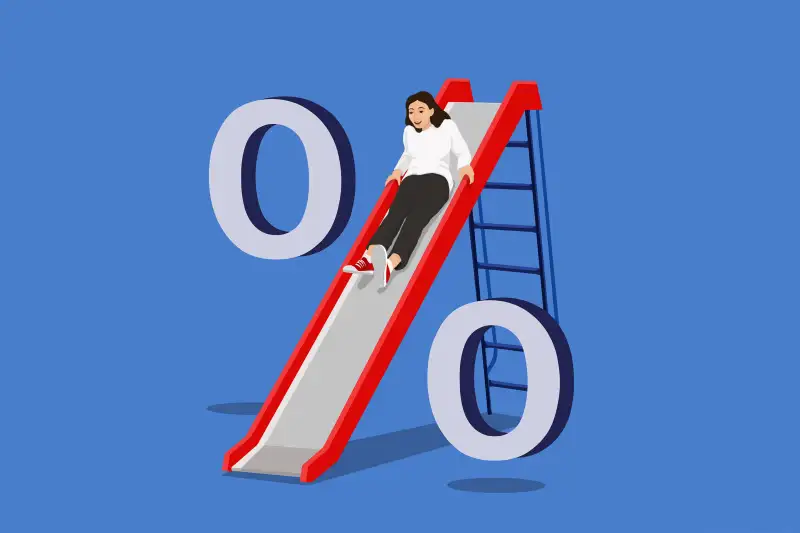Is Now a Good Time to Refinance Your Mortgage?

Mortgage rates increased at one of the fastest paces on record in 2023, rising by nearly two full percentage points since the start of the year. At the same time, most homeowners currently have a mortgage rate below 4%, which makes a mortgage refinance an impractical choice.
Experts say a refinance makes sense if you can lower your current interest rate by at least 0.75 percentage points.
However, mortgage rates signs of stabilizing and have come off their recent highs. If that downward trend continues, recent buyers in particular may find they can benefit from a rate and term refinance this year.
If you're not sure a refi is right for you, we can help you make that decision. Once you've determined you are ready to refinance, you can find the right lender for you by shopping around the best mortgage refinance companies.
- If your mortgage rate is below 6.67%, now is not a good time to refinance
- What are today’s mortgage refinance rates?
- When should you refinance your mortgage?
- How to refinance your mortgage
- Mortgage refinance FAQ
If your mortgage rate is below 6.67%, now is not a good time to refinance
If your current mortgage rate is above 6.67%, refinancing might make sense. However, if your current is lower, refinancing is probably a bad idea right now.
Why? That's the current average rate on a 30-year fixed-rate loan. So if you were to refinance from a lower-rate mortgage, the rate on your new mortgage will most likely be higher than it is right now. That translates into higher monthly payments over the life of the loan.
According to mortgage experts, a refinance generally makes sense if you can lower your interest rate by at least 0.75%, although a decrease of 0.50% could also be worthwhile. When deciding whether a refi makes financial sense, you want to calculate your break-even point. This is the number of months it will take to recoup the costs of the refinance — the sooner you can recover them, the better.
Using a mortgage refinance calculator gives you an idea of what your new payment will be and help you decide whether a refi makes sense given your financial situation.
Most homeowners opt for a rate and term refinance. This is when you take out a new loan with a lower interest rate and reset the term on your old loan. While a rate and term refi may not make sense at the moment, there are other reasons a refi might make sense for your circumstances.
For instance, a cash-out refinance is a way to take advantage of the home equity you’ve gained over the years. You may be coming to the end of the variable period on an adjustable-rate mortgage and want to lock in a rate by refinancing into a fixed-rate loan rather than risking an even higher interest rate.
What are today’s mortgage refinance rates?
The average rate on a 30-year fixed-rate mortgage loan is 6.67%, according to Freddie Mac data for the week ending May 4. Historically speaking, mortgage rates are lower than average. The rate average for a 30-year fixed-rate mortgage over the last 50 years has been slightly under 8%.
However, compared to 2021, when rates reached a record low of 2.65%, today’s mortgage rates are considerably higher.
Mortgage rates increased at a stunningly fast pace between January and November 2022. The rapid increase was a result of the Federal Reserve increasing the federal funds rate to fight high inflation. As the fed funds rate moved higher, rates on all kinds of debt, from personal and student loans to credit cards and mortgages, increased as well.
In general, rates charged on refi loans tend to be a bit higher than rates on purchase loans.
What do today’s mortgage refinance rates mean for you?
With mortgage interest rates significantly higher than they have been over the past few years, a refinance is not a good idea for most homeowners right now, especially for those who took advantage of historically low rates in 2020 and 2021 to refinance and are currently sitting on sub-4%. However, some people may still be able to lock in a lower rate.
If the rate on your current loan is above 6.67%, you may want to consider a mortgage refinance, as long as you can reduce that rate by at least 0.50% or more.
For example, if you have an outstanding balance of $300,000 on a 30-year loan and you qualify to reduce your current rate from 7% to 6.50%, you’ll reduce your monthly mortgage payment by $100 a month or $1,200 per year. If you can qualify for a 6% rate, you’ll save $197 per month. To take full advantage of the potential savings, make sure you stay in the home long enough to break even and recover the cost of the refi.
The example above assumes you are doing a rate and term refinance into another 30-year fixed-rate mortgage. But, if your finances have improved significantly, you also have the option of refinancing into a shorter-term loan like a 15-year fixed-rate mortgage, which typically has a lower interest rate.
A shorter-term mortgage loan means you will pay off the loan faster and save on interest, but the trade-off is that your monthly payments will be higher.
When should you refinance your mortgage?
When you should refinance is more a matter of your personal financial situation than trying to time it perfectly.
Don’t try to time the market. Waiting on rate swings is as troublesome as timing the stock market. If you can save money or move closer to your financial goals by refinancing today, don’t wait to see what happens with mortgage interest rates tomorrow.
Consider these key points when deciding whether to refinance your mortgage:
Your credit score
With most mortgage lenders, you’ll need a credit score of at least 620 to qualify for a mortgage refinance. To get the lowest mortgage rate, you’ll need a 740.
Also keep in mind that, if your credit is lower than it was when you took out your current mortgage, you may not qualify for as favorable a rate as you did before.
Your credit report
Your credit score is based on information contained in your credit report. If there are errors in the report, it could cause a lender to offer a higher interest rate. Request a copy of your credit report, check it for mistakes and take steps to correct it.
Your debt-to-income ratio (DTI)
Your debt-to-income ratio is the percentage of your gross monthly income that is used to pay your monthly debts. Lenders use your DTI to determine your credit risk.
For conventional loans, some lenders will work with a DTI as high as 43%. FHA loans will go a little higher, usually accepting DTIs of 50%. Lower, however, is generally better.
How long you’re staying
When you refinance, you’ll need to pay closing costs. If you plan to move out in the near future, you may not break even.
How much equity you have in your home
In order to qualify for a mortgage refinance you generally need at least 20% equity in your home.
How to refinance your mortgage
These tips can help you start the refinancing process.
Determine your refinancing goal
Ask yourself what you want to achieve by refinancing. It could be reducing your current interest rate, changing the term of your loan, switching from an adjustable-rate mortgage to a fixed-rate loan or cashing out the equity you’ve built up. Defining a goal helps you narrow down what type of loan best suits your needs.
Consider how the loan term may change
Refinancing may extend or reduce the amount of time you’ll be paying the mortgage. For example, if you have already paid 10 years of your current 30-year mortgage and refinance into another 30-year loan, you will be paying your mortgage for a total of 40 years. If you refinance into a 15-year loan, your total payback time is cut to 25 years.
Shop around for a lender
Look beyond your current lender. Mortgage rates are very variable, and you may be able to find a lower rate by looking at multiple lenders. Consider banks, credit unions and online lenders.
Compare what they offer, then apply to 3-5 lenders that offer the best rate and terms. Your credit score won’t be negatively impacted if you make multiple applications within a 14-day period. If possible, obtain a mortgage preapproval letter from several different lenders and compare the offers.
Calculate your breakeven point
In addition to comparing the rate different lenders offer, calculate your breakeven point, or how long it will take you to recover the cost of refinancing. Closing costs, which include application and origination fees, total between 2% and 6% of the new loan amount and are typically paid upfront.
Calculate your breakeven point by dividing your total costs by the amount you’ll save each month. The result will be the number of months it takes to recover those costs.
Prepare your home for an appraisal
Having your home appraised is part of the refi process. It helps determine the value of your home and can affect how much a lender is willing to refinance. Prep your home by decluttering the home’s interior and sprucing up the yard. Have receipts for any improvements you’ve made and be present at the appraisal to answer questions.
Lock in your rate
Don’t count on mortgage rates dropping significantly in the foreseeable future. Mortgage experts believe rates will stay elevated through the end of the year. Once you find a rate you can comfortably afford, lock it in.
Mortgage Refinance FAQ
Are refinance rates going down?
Refinance rates are not expected to decrease significantly in the near future. Most experts expect rates to remain elevated although there may be occasional dips. Homeowners who find a good rate should lock it in to avoid having to refi at a potentially higher rate later.
Why would refinancing be a bad idea?
Refinancing is a bad idea if it doesn’t represent some sort of gain, be it in the form of lower monthly payments or long-term savings. If the interest rate being offered isn’t 0.5 percentage points lower than your current rate, it’s probably not worth the cost of a refi — it would take too long to break even with a smaller reduction. You’ll need to do the math to figure out your break-even point or if the new monthly payment is more than you can comfortably afford.
Is it cheaper to refinance with my current lender?
It is not necessarily cheaper to refinance with your current lender. While it is possible having an established relationship could lead to more favorable rates or fee discounts, it’s not a guarantee. Your best option for finding the best mortgage rate is to shop around and consider different types of lenders, including banks, mortgage brokers, online lenders and credit unions.
How do I get the best refinance loan rates?
Try to go through the mortgage preapproval process with at least three lenders to make sure you are getting the best deal. You can also improve your chances of qualifying for a better rate by getting your personal finances in shape. Improve your credit score, lower your debt-to-income ratio and beef up your cash reserves. You should also shop around for a lender to find the one with the best rate and terms.

